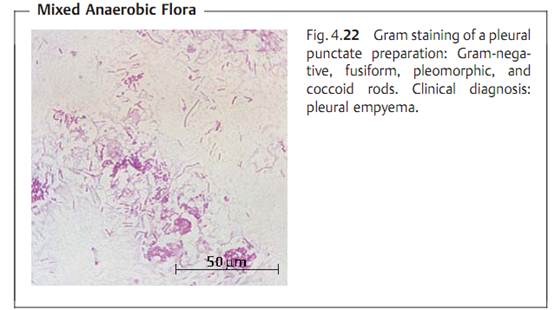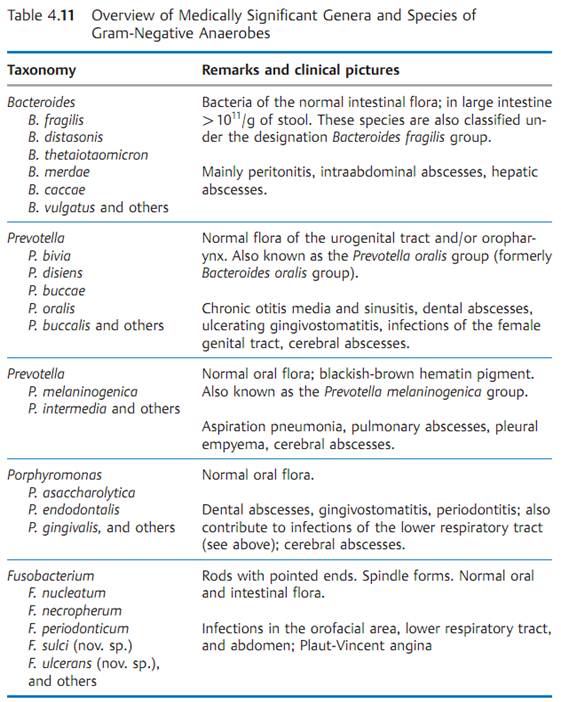


 النبات
النبات
 الحيوان
الحيوان
 الأحياء المجهرية
الأحياء المجهرية
 علم الأمراض
علم الأمراض
 التقانة الإحيائية
التقانة الإحيائية
 التقنية الحيوية المكروبية
التقنية الحيوية المكروبية
 التقنية الحياتية النانوية
التقنية الحياتية النانوية
 علم الأجنة
علم الأجنة
 الأحياء الجزيئي
الأحياء الجزيئي
 علم وظائف الأعضاء
علم وظائف الأعضاء
 الغدد
الغدد
 المضادات الحيوية
المضادات الحيوية|
Read More
Date: 9-3-2016
Date: 1-3-2016
Date: 10-3-2016
|
Gram-Negative Anaerobes
The obligate anaerobic, Gram-negative, pleomorphic rods are components of the normal mucosal flora of the respiratory, intestinal, and genital tracts. Among the many genera, Bacteroides, Prevotella, Porphyromonas, and Fusobacterium, each of which comprises numerous species, are of medical significance. They cause endogenous necrotic infections with sub-acute to chronic courses in the CNS, head, lungs, abdomen, and female genitals. A typical characteristic of such infections is that a mixed flora including anaerobes as well as aerobes is almost always found to be causative. Laboratory diagnostic procedures seek to identify the pathogens. Special transport vessels are required to transport specimens to the laboratory. Identification is based on morphological and physiological characteristics. A special technique is GC organic acid assay. Potentially effective antibiotics include certain penicillins and cephalosporin, clindamycin, and metronidazole.
Occurrence. These bacteria include a large and heterogeneous group of Gram-negative, non-sporing, obligate anaerobe rods, many of which are components of the normal human mucosal flora. Their numbers are particularly large in the intestinal tract, where they are found 1000 x as frequently as Enterobacteriaceae. They also occur regularly in the oral cavity, upper respiratory tract, and female genitals.
Classification. The taxonomy and nomenclature has changed considerably in recent years. The families Bacteroidaceae, Prevotellaceae (nov. fam.), Porphyr- omonadaceae (nov. fam.), and Fusobacteriaceae (nov. fam.) include significant human pathogens (Table 4.11).
Morphology and culture. The Gram-negative anaerobes show a pronounced pleomorphy; they are straight or curved, in most cases non-motile, Gram- negative rods. Fusobacteria often take on gram staining irregularly and frequently feature pointed poles (Fig. 4.22). Culture growth is only achieved under stringent anaerobic conditions. Some species are so sensitive to oxygen that the entire culturing procedure must be carried out in an anaerobic chamber (controlled atmosphere glove box). Anaerobes proliferate more slowly than aerobes, so the cultures must be incubated for two days or more.
Pathogenesis and clinical pictures. Infections with Gram-negative anaerobes participation are almost exclusively endogenous infections. The organisms show low levels of pathogenicity. They therefore are not found to feature any spectacular pathogenicity They therefore are not found to feature any spectacular pathogenicity factors like clostridial toxins. Some have a capsule to protect them from phagocytosis. Some produce various enzymes that destroy tissues (hyaluronidase, collagenase, neuraminidase). Gram-negative anaerobes are almost never the sole pathogens in an infection focus, but are rather found there together with other anaerobes and aerobes.

The clinical course of infections is sub-acute to chronic. Necrotic abscesses are seen frequently. The compartments infected are the CNS, the oral cavity, the upper and lower respiratory tract, the abdominal cavity, and the urogenital tract (Table 4.11). These pathogens can infect wounds following bite injuries or surgery in areas colonized by them (intestine, oral cavity, genital tract).
Diagnosis requires isolation and identity of the bacteria involved. Since these anaerobes are components of normal flora, correct sampling techniques are very important. The material must be transported in special anaerobe containers. Cultures should always be grown under both anaerobic and aerobic conditions. Selective culture mediums are available. Identification is based on morphological and physiological characteristics. Gas chromatography can be used for organic acid assays (butyric acid, acetic acid, propionic acid, etc.). These acids are produced as final products of certain bacterial metabolic steps.
Therapy. Penicillin, usually in combination with a betalactamase inhibitor, clindamycin, cefoxitin, imipenem, and nitroimidazoles are potentially effective antibiotics. Resistance testing is only necessary in certain cases.

Epidemiology and prevention. Most infections arise from the patient’s own flora. Exogenous infections can be contracted from animal bites. Following intestinal surgery, suitable anti-infective agents (see above) are administered for one to two days to prevent infections.



|
|
|
|
لشعر لامع وكثيف وصحي.. وصفة تكشف "سرا آسيويا" قديما
|
|
|
|
|
|
|
كيفية الحفاظ على فرامل السيارة لضمان الأمان المثالي
|
|
|
|
|
|
|
قسم التربية والتعليم يطلق الامتحانات النهائية لمتعلِّمات مجموعة العميد التربوية للبنات
|
|
|